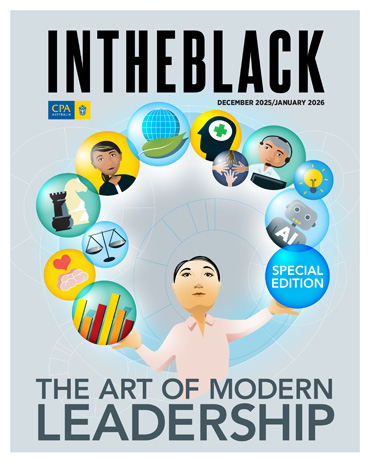Loading component...
At a glance
- In Australia, around one in six women and one in 12 men are victims of financial abuse from a partner.
- The ATO was recently externally reviewed to examine possible relief from tax debt for victims of financial abuse.
- Accountants and financial professionals can help identify warning signs that may indicate abuse.
This article discusses financial abuse including coercion, control and exploitation. If this topic is distressing or triggering, please proceed with caution. If you or someone you know is experiencing financial abuse, support and resources are available at 1800RESPECT in Australia or your local authority overseas. Please prioritise your well-being.

When Julie Dal Pra thinks about the complex issue of economic abuse, it is often fraud, deception and manipulation that come to mind.
As a small business financial counsellor at community health service Each, Dal Pra sees many instances of the unlawful control of money and finances, ranging from signing someone up as a director of a company without their knowledge to lodging a false income tax return.
“I often say this kind of financial abuse is hidden in plain sight,” Dal Pra says.
This includes moving assets or money around, putting liabilities in the victim’s name while the perpetrator keeps the assets and income in their own name, or taking the money but reporting it under someone else’s name, Dal Pra says.
“Taking vulnerabilities into account hasn’t been a focus in the professional or commercial sectors. Unfortunately, because of this, people who are not involved in the business can still be held liable.
“We are talking about cases ranging from millions of dollars to much smaller amounts,” she says.
While the amounts can vary depending on the circumstances, when the abuse is related to director penalty notices, the amounts at stake are usually significant.
"The perverse thing is that the victim survivor is guilty until proven innocent. The burden and cost are on them to prove it, which they can’t afford, so they just end up with the debt."
“Where someone has been made a director without their knowledge, usually the first they hear about it is when there is a tax compliance issue and they receive a notice from the Australian Taxation Office [ATO],” says Dal Pra.
“The director penalty notices go straight to lockdown, meaning there’s no 21-day period to take action. And these amounts aren’t small.”
In the 2023–24 financial year, the ATO issued over 26,000 director penalty notices for company debts totalling over A$4.4 billion. Equally divided — for example’s sake this is over A$160,000 per notice.
The actual numbers may be lower and the type of abuse different, but the impact is just as devastating.
“The perverse thing is that the victim survivor is guilty until proven innocent. The burden and cost are on them to prove [financial abuse], which they can’t afford, so they just end up with the debt,” she says.
Responding to Indicators of Financial Distress course
Identifying abuse
The emotional toll of dealing with the legal and financial battles, and the economic abuse itself, can be overwhelming. It often leads to severe hardships, such as homelessness, lack of access to employment, a poor credit rating and long-term health issues.
This form of abuse is shockingly common and does not discriminate along socio-economic lines. According to the Australian Bureau of Statistics, one in six women and one in 12 men are victims of economic abuse from a partner.
In New Zealand, the results are similar, with research reporting that 15 per cent of New Zealand women have experienced some form of economic harm by an intimate partner.
Economic abuse can occur alone or alongside other forms of family violence, including physical and mental abuse, and has devastating consequences for the victim survivor, says Dr Ayesha Scott, adjunct senior lecturer at Auckland University of Technology and senior lecturer in Finance and Financial Planning at Griffith University.
“We know that most victim survivors of other types of family violence, like physical and mental abuse, also experience financial and economic abuse — and it is a key barrier to safety,” she says.
Importantly, financial control can be exerted over anyone. For older people, it may involve someone they know using emotional blackmail to pressure the older person into giving them money or financial control in return for access to care or contact, Scott reports.
“It limits opportunities to live a full life — either through a lack of financial resources or undermining someone’s ability to make their own decisions about their money and life generally,” she says.
Having financial organisations and professionals in the sector that respond well to disclosures or identification of financial abuse is key to managing that vulnerability, Scott argues.
Fixing the system
Financial abuse can be a tricky area to combat because it can cover multiple areas of the law, including tax law, company law, family law and so on. Given this, multiple regulators have different areas of responsibility.

Ruth Owen CBE, Australia’s inspector-general of taxation and taxation ombudsman, is acutely aware of the situation, which has been the focus of her first review since her appointment in July 2024.
The review examined the ATO’s current systems, policies and processes to identify and manage financial abuse and coercive control within the tax and superannuation systems. CPA Australia made a submission as part of this investigation in December 2024.
“I think the issue of financial abuse is gaining significant momentum and attention in public policy. We have received valuable input from academics and community organisations supporting victim survivors of domestic violence, and the tax sector itself is starting to recognise this as a serious problem that we need to address,” she says.
“The Parliamentary Joint Committee took a much broader approach than my remit allows, examining the entire financial system, ASIC and directorships, child support, family law, insurance and developments in state and territory legislation, as well as considering potential policy changes to make it more difficult for abuse to occur.”
"We’re seeing complaints from people saying they’ve had director’s penalty notices in respect of the company tax debt, and they didn’t even know they were a director of the company, let alone that they were actually liable for debts."
Owen’s review, which was released in April, is focused on the practical things that the ATO could do now to identify and support victim survivors of financial abuse.
“The most common cases we are seeing is the misuse of directorships. These are where spouses have unknowingly or under coercion become directors of companies of which they have had no control.
We’re seeing complaints from people saying they’ve had director’s penalty notices in respect of the company tax debt, and they didn’t even know they were a director of the company, let alone that they were actually liable for debts,” Owen reports.
The accountant's role in stamping out financial abuse
Vulnerable circumstances
Another example is how the tax system can be weaponised in relation to child support.
“One of the more insidious ways we’ve seen this is where perpetrators avoid lodgement of their income tax returns or under-report their income, which in turn delays their assessment for child support obligations,” Owens says.
Dal Pra agrees. “The main goal of financial abuse is usually to lower income, especially for things like child support.”
“Further abuse occurs where outstanding lodgements are brought up to date, shifting the income position and creating other debts for the victim survivor, such as Family Tax Benefit debts,” Owen says.
Scott says that abuse can involve restricting access to money or bank accounts, concealing financial details, taking on debt without the other person’s consent, undermining job or educational prospects, or more commonly after separation, manipulating financial circumstances to reduce child support obligations.
The ATO says it is aware of the growing number of taxpayers presenting with a range of vulnerable circumstances and the impacts of financial abuse and coercion are of considerable concern.
“We are committed to ensuring we do our part to enhance the way the system can operate to both prevent and improve the response to these impacts,” a spokesperson says.
“The ATO wants to reassure taxpayers [that] there are options available for those who are experiencing vulnerable circumstances, and they should discuss any support they need with the ATO.
This includes pausing recovery action to give the taxpayer time to seek advice and support.” It is an approach Owen considered in the review.
“Outside of the courts and tribunals, there are very limited circumstances in which the ATO can permanently remove a debt from a taxpayer’s account. We are aware these limited powers are not specifically aimed at combatting financial abuse,” she says.
“We considered in our review what is possible within the existing powers of the ATO to both give relief or release tax debt for victim survivors on tax debt that they had no actual involvement in creating. Where new powers are required, this would be a matter for the government to consider.”
Know the signs of financial abuse

In New Zealand, economic abuse is not categorised as a crime under legislation. However, it can be partly addressed through the Family Violence Act 2018, where certain forms of economic abuse may be recognised under psychological abuse, says Brittany Goodwin, senior social policy and advocacy advisor, Good Shepherd New Zealand.
“Recognising [that] it takes time for legislation to change, we are advocating for operational changes within creditors, banks and lenders to do what they can to not only recognise economic harm and help people through referral pathways, but also to look at how debt can be wiped where appropriate,” she says.
Accountants and finance professionals should keep an eye out for the following signs of potential abuse:
- Clients who bring signed documents to meetings that the signee never attends.
- When a client asks to add someone as a company director.
- If a client is suddenly showing signs of financial distress or difficulty accessing their own accounts.
- Unexplained changes to financial arrangements or assets being transferred without clear consent.
- One party having excessive control over the financial decisions of another, as well as access to important documents such as bank statements or identification.
“Some of our clients tell us that they’ve been in a relationship for 10 years and their partner knows where their license and passport are kept. They can take those forms of ID and approach creditors or banks and take out loans without them knowing — or even forge their signature,” Goodwin says.
“A major focus for us is ensuring that banks, financial services and accountants, when relevant, are able to recognise these signs and, most importantly, become more aware that economic abuse is happening,” she adds.
CPA Australia has resources available for accountants to help prevent financial abuse and its impact.
Financial abuse in the tax system

Ruth Owen CBE, Australia’s inspector-general of taxation and taxation ombudsman, released a report in April examining how the taxation system is being used as a weapon of financial abuse. It recommends a series of measures the Australian Tax Office (ATO) and other organisations can take to better combat the problem.
“It’s shocking that the tax system is being used as a weapon to inflict financial and emotional damage on unsuspecting and vulnerable individuals,” says Owen. “The stories we heard during our review were very disturbing, particularly because so many victims only find out about the abuse when they receive a bill from the ATO.”
While the report recognised work done by the ATO to prevent financial abuse in areas like welfare and child support, it said more needed to be done in four key areas:
- Increased training for frontline ATO workers to help them identify financial abuse, as well as a specialist, central team to be a point of referral.
- More support and relief for victim-survivors, including better guidelines and procedures.
- Holding perpetrators to account, which includes a review of existing powers and more accessible communication channels for abuse reporting.
- More involved interaction between the ATO and other government agencies on financial abuse.

